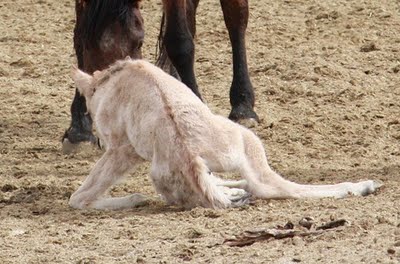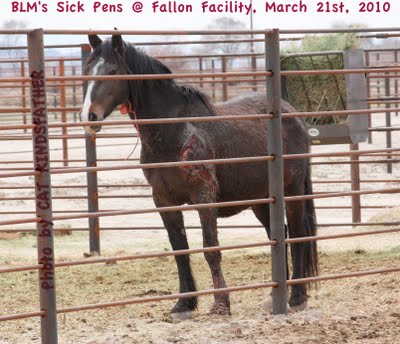


Seven Tears Into the Sea
Phantom Stallion Series

Bio
Weblog
Q&A
Schedule
Media



Saturday, April 03, 2010
Phantom foals

photo used by permission of Cat Kindsfather
Three things to think about:
1) Newborn horses like the dun foal above -- trying to rise and nurse despite a broken leg suffered in a corral crowded with adult horses -- do not exist in the world of BLM until they are branded.
2) Only one vet is under contract to care for the thousands of mustangs in BOTH the Fallon and Palomino Valley facilities.
3) Despite promises to welcome the public at wild horse gathers and holding pens, program manager Don Glenn allows NO humane observers at the wild horse facilities except "by appointment"
If you object, please sign this petition to President Obama, asking for
an immediate moratorium on wild horse roundups
Permalink to this blog post
Posted by Terri Farley @ 2:00 AM 7 comments


Friday, April 02, 2010
Pigeon Fever Plagues Calico Horses

photo by Cat Kindsfather
Dear Readers,
The misery visited on the wild horses of the Calico mountains goes on.
Pigeon Fever was diagnosed by visitors to the feedlot style holding pens in Fallon, a place called Indian Lakes. Sounds nice, doesn't it?
Sadly, the photo I showed you a few days ago -- -shown again above -- could be a horse suffering from this condition.
Treatment for Pigeon Fever includes warm compresses, ISOLATION and hygenic conditions. Wild horses at Indian Lakes are getting none of this treatment.
Why?
"The incidence of Pigeon Fever at the Indian Lake Facility is at the same percentages that exist on the Calico Complex," BLM's contract vet, Dr. Sanford says, so "no treatments have been administered to date."
Even if this condition crops up on the range, too, horses running free do NOT stand around with two thousand other mustangs in crowded conditions where they can't avoid contact with each others' streaming pus.
Gross? Yes, and maybe that's why BLM is not only closing Indian Lakes to visitors on Easter Sunday, but director Don Glenn has refused to schedule a make-up day.
Secrecy leads to suspicion, and since day 1 of the Calico round up, it's been justified.
If BLM won't take even basic precautions -- like putting infected horses in hospital pens -- could it be because they want an excuse NOT to free them back to their home range? Or is it just too much trouble?
Best,
Terri
More info on Pigeon Fever from Colorado State veterinarians:
Clinical signs: Early signs can include lameness, fever, lethargy, depression and weight loss.
Infections can range from mild, small, localized abscesses to a severe disease with multiple massive abscesses containing liters of liquid, tan-colored pus.
External, deep abscesses, swelling and multiple sores develop along the chest, midline and groin area, and, occasionally, on the back.
Incubation period: Horses may become infected but not develop abscesses for weeks.
Animals affected:The disease usually manifests in younger horses, but can occur in any age, sex, and breed.
A different biotype of the organism is responsible for a chronic contagious disease of sheet and goats, Caseous lymphadenitis, or CL. Either biotype can occur in cattle.
Disease forms: Generally 3 types: external abscesses, internal abscesses or limb infection (ulcerative lymphangitis).
The ulcerative lymphangitis is the most common form worldwide and rarely involves more than one leg at a time. Usually, multiple small, draining sores develop above the fetlock.
The most common form of the disease in the United States is external abscessation, which often form deep in the muscles and can be very large. Usually they appear in the pectoral region, the ventral abdomen and the groin area. After spontaneous rupture, or lancing, the wound will exude liquid, light tan-colored, malodorous pus.
Internal abscesses can occur and are very difficult to treat
.
Treatment: Hot packs or poultices should be applied to abscesses to encourage opening. Open abscesses should be drained and regularly flushed with saline.
Surgical or deep lancing may be required, depending on the depth of the abscess or the thickness of the capsule, and should be done by your veterinarian.
Ultrasound can aid in locating deep abscesses so that drainage can be accomplished.
External abscesses can be cleaned with a 0.1 percent povidone-iodine solution
Antiseptic soaked gauze may be packed into the open wound
A nonsteroidal anti-inflammatory drug such as phenylbutazone can be used to control swelling and pain
Care required: Buckets or other containers should be used to collect pus from draining abscesses and this infectious material should be disposed of properly.
Consistent and careful disposal of infected bedding, hay, straw or other material used in the stall is vitally important.
Thoroughly clean and disinfect stalls, paddocks, all utensils and tack.
Pest control for insects is also very important.
Recovery time: Usually anywhere from two weeks to 77 days.
Permalink to this blog post
Posted by Terri Farley @ 3:01 PM 5 comments


Phantom foals

photo used by permission of Cat Kindsfather
Three things to think about:
1) Newborn horses like the dun foal above -- trying to rise and nurse despite a broken leg suffered in a corral crowded with adult horses -- do not exist in the world of BLM until they are branded.
2) Only one vet is under contract to care for the thousands of mustangs in BOTH the Fallon and Palomino Valley facilities.
3) Despite promises to welcome the public at wild horse gathers and holding pens, program manager Don Glenn allows NO humane observers at the wild horse facilities except "by appointment"
If you object, please sign this petition to President Obama, asking for
an immediate moratorium on wild horse roundups
Labels: BLM, Don Glenn, Indian Lakes, mustangs, Palomino Valley, phantom foals, pigeon fever, terri farley, wild horse deaths, wild horses
Permalink to this blog post
Posted by Terri Farley @ 2:00 AM 7 comments
Friday, April 02, 2010
Pigeon Fever Plagues Calico Horses
photo by Cat Kindsfather
Dear Readers,
The misery visited on the wild horses of the Calico mountains goes on.
Pigeon Fever was diagnosed by visitors to the feedlot style holding pens in Fallon, a place called Indian Lakes. Sounds nice, doesn't it?
Sadly, the photo I showed you a few days ago -- -shown again above -- could be a horse suffering from this condition.
Treatment for Pigeon Fever includes warm compresses, ISOLATION and hygenic conditions. Wild horses at Indian Lakes are getting none of this treatment.
Why?
"The incidence of Pigeon Fever at the Indian Lake Facility is at the same percentages that exist on the Calico Complex," BLM's contract vet, Dr. Sanford says, so "no treatments have been administered to date."
Even if this condition crops up on the range, too, horses running free do NOT stand around with two thousand other mustangs in crowded conditions where they can't avoid contact with each others' streaming pus.
Gross? Yes, and maybe that's why BLM is not only closing Indian Lakes to visitors on Easter Sunday, but director Don Glenn has refused to schedule a make-up day.
Secrecy leads to suspicion, and since day 1 of the Calico round up, it's been justified.
If BLM won't take even basic precautions -- like putting infected horses in hospital pens -- could it be because they want an excuse NOT to free them back to their home range? Or is it just too much trouble?
Best,
Terri
More info on Pigeon Fever from Colorado State veterinarians:
Clinical signs: Early signs can include lameness, fever, lethargy, depression and weight loss.
Infections can range from mild, small, localized abscesses to a severe disease with multiple massive abscesses containing liters of liquid, tan-colored pus.
External, deep abscesses, swelling and multiple sores develop along the chest, midline and groin area, and, occasionally, on the back.
Incubation period: Horses may become infected but not develop abscesses for weeks.
Animals affected:The disease usually manifests in younger horses, but can occur in any age, sex, and breed.
A different biotype of the organism is responsible for a chronic contagious disease of sheet and goats, Caseous lymphadenitis, or CL. Either biotype can occur in cattle.
Disease forms: Generally 3 types: external abscesses, internal abscesses or limb infection (ulcerative lymphangitis).
The ulcerative lymphangitis is the most common form worldwide and rarely involves more than one leg at a time. Usually, multiple small, draining sores develop above the fetlock.
The most common form of the disease in the United States is external abscessation, which often form deep in the muscles and can be very large. Usually they appear in the pectoral region, the ventral abdomen and the groin area. After spontaneous rupture, or lancing, the wound will exude liquid, light tan-colored, malodorous pus.
Internal abscesses can occur and are very difficult to treat
.
Treatment: Hot packs or poultices should be applied to abscesses to encourage opening. Open abscesses should be drained and regularly flushed with saline.
Surgical or deep lancing may be required, depending on the depth of the abscess or the thickness of the capsule, and should be done by your veterinarian.
Ultrasound can aid in locating deep abscesses so that drainage can be accomplished.
External abscesses can be cleaned with a 0.1 percent povidone-iodine solution
Antiseptic soaked gauze may be packed into the open wound
A nonsteroidal anti-inflammatory drug such as phenylbutazone can be used to control swelling and pain
Care required: Buckets or other containers should be used to collect pus from draining abscesses and this infectious material should be disposed of properly.
Consistent and careful disposal of infected bedding, hay, straw or other material used in the stall is vitally important.
Thoroughly clean and disinfect stalls, paddocks, all utensils and tack.
Pest control for insects is also very important.
Recovery time: Usually anywhere from two weeks to 77 days.
Labels: BLM, Craig Downer, Don Glenn, Fallon, Fallon facility, Indian Lakes, Pgeon Fever, terri farley
Permalink to this blog post
Posted by Terri Farley @ 3:01 PM 5 comments